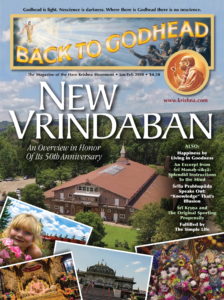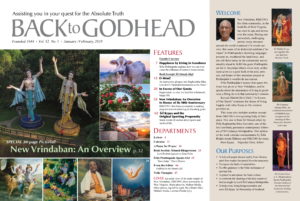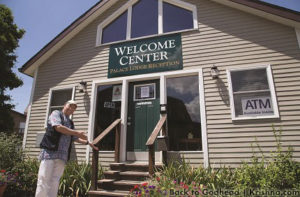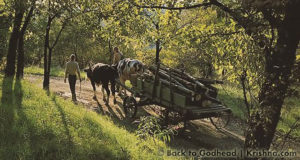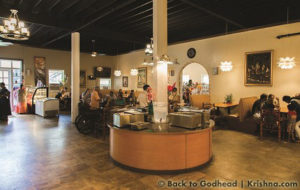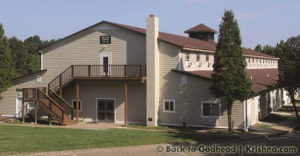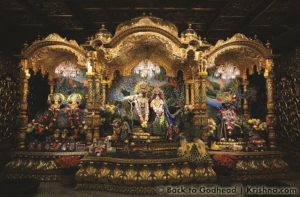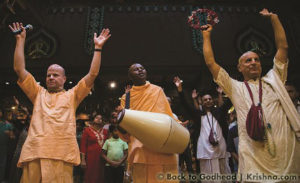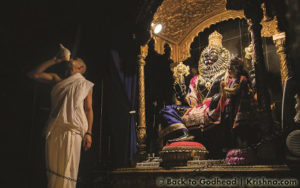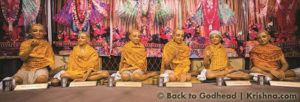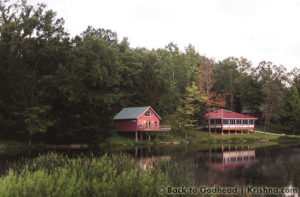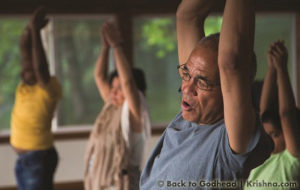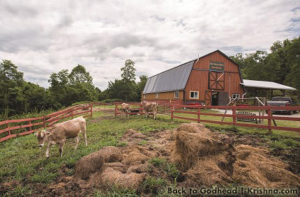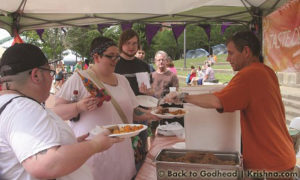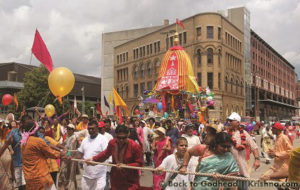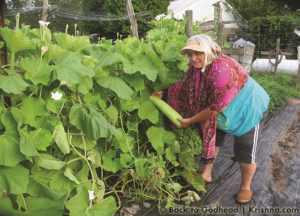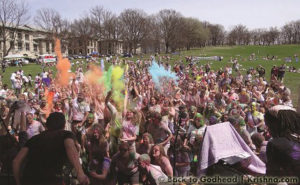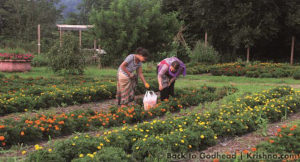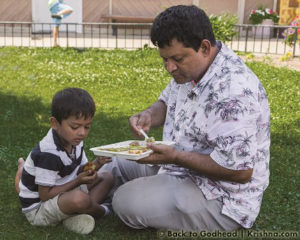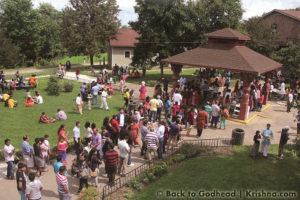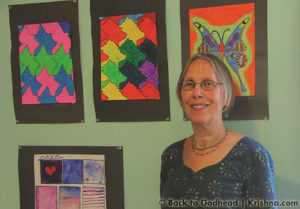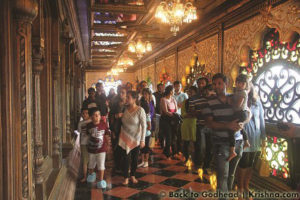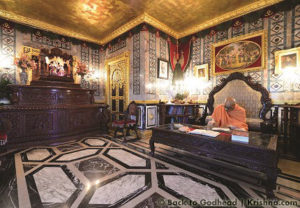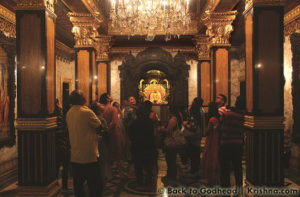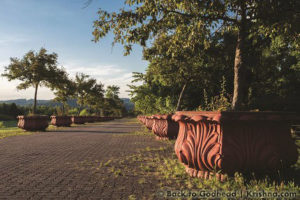Back to Godhead: New Vrindaban – An Overview in Honor of Its 50th Anniversary
Back to Godhead Magazine, January/February 2018 issue
New Vrindaban: An Overview in Honor of Its 50th Anniversary
By Satyaraja Dasa
Archival Research by Chaitanya Mangala Dasa
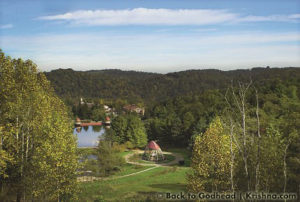
A view from Govardhan Hill of Sri Sri Radha Vrindaban Chandra’s temple and guest lodge, with Kusum Sarovara Lake and the peackock and swan aviary in the foreground.
With the successful worldwide celebration of ISKCON’s fiftieth anniversary in 2016, another semicentennial event naturally follows in its wake: commemoration of the founding of New Vrindaban in 1968, two years after ISKCON’s founding. By establishing this farm community, Srila Prabhupada hoped his followers and eventually the rest of the world would embrace the Krishna conscious ideal of “simple living and high thinking.” This could be accomplished, he taught, by underscoring five important components of a back-to-the-land Vedic ideal, beginning with (1) cow protection, (2) simple living, (3) spiritual education, and (4) holy pilgrimage. Under the right direction, he added, these four can lead to the most important component of all: (5) loving Krishna.
This article has two parts. The first is an overview of New Vrindaban – what it is, how it started, and what it has accomplished. The second focuses on four devotees who bring to life the five components that Prabhupada mandated for New Vrindaban. While the community has produced a multitude of devotees who could be singled out for their consummate service, these four, each with a penchant for one of the initial components mentioned above, will serve as a sample. Their stories show how the fifth component, loving Krishna, is the natural result of properly engaging in New Vrindaban’s central activities.
Part I: Origins and Development

Srila Prabhupada delivers his Bhagavat Dharma discourses during the 1972 Vyasapuja & Janmastami celebrations on Govindaji Hill at the Bahulaban farm.

Srila Prabhupada tours his under construction Palace during his final visit to New Vrindaban in 1976
Vrindavana is Krishna’s paradise in the spiritual world, the kingdom of God described in the ancient wisdom texts of India. A replica of this realm exists even today as a village in the Mathura district of Uttar Pradesh, India, where Krishna walked the earth some five thousand years ago. Soon after Prabhupada arrived in the West, in 1965, he envisioned yet another replication of Vrindavana – New Vrindaban.1
In May 1956, Prabhupada wrote a two-part Back to Godhead article about the potential for such a project in the Western world. The article promoted the notion of a community of devotees living close to nature according to the principles of the Bhagavad-gita. He called the project Geeta Nagari (the name of his subsequent farm in Port Royal, Pennsylvania).
Vrindavan’s initial Western counterpart came to be through the agency of two early disciples, Kirtanananda Swami and Hayagriva Dasa. In the winter of 1968 they saw a brief newspaper article in which an enterprising landowner-turned-yogi, Richard Rose, mentioned that he was looking for people to create an ashram in Marshall County, West Virginia. “The conception is one of a non-profit, non-interfering, non-denominational retreat or refuge,” read the almost prescient article, “where philosophers might come to work communally together, or independently, where a library and other facilities might be developed.”2
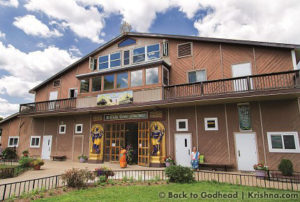
The front entrance to Sri Sri Radha Vrindaban Chandra’s temple, guarded by Jaya and Vijaya, the Vaikuntha Gatekeepers.
Several months later, Kirtanananda and Hayagriva, who had temporarily developed a strained relationship with their spiritual master, set out on their own to visit the land. They negotiated with the owner and reached a provisional financial agreement. Kirtanananda settled there for a few months in a farmhouse in the woods.
That summer, he and Hayagriva visited Prabhupada in Canada to make amends. His Divine Grace “forgave his renegade disciples in Montreal with a garland of roses and a shower of tears.”3 With Prabhupada’s approval they returned to West Virginia and leased the property. A month later Prabhupada wrote to them, “Now we can work with great enthusiasm for constructing a New Vrindaban in the United States of America.”4
Excited about his new project, Prabhupada had his secretary, Brahmananda Dasa, write to the various ISKCON centers asking those devotees who were able and inclined to support New Vrindaban by visiting if not staying on and lending manpower.5 He had already given the land its special name in an earlier letter: “You have New York, New England, and so many ‘New’ duplicates of European countries in the USA, why not import New Vrindaban in your country?”6
Soon after the arrival of Brahmananda’s letter – that same month, in fact – New Vrindaban’s first deities of Sri Sri Radha-Krishna made Their appearance as well: A small pair of bell-metal murtis, compliments of a devotee who had just returned from India. Prabhupada was delighted. “I am very glad to learn that Harivilas has given you a pair of Radha-Krishna Murtis, so it appears that Radha-Krishna is very kind on you, because you went to Vrindaban to live there but circumstantially, you could not live there, and you left. Krishna has given you New Vrindaban, as well as, out of His good will, He has come to you. It is very surprising. So please welcome the Deity and install Him in a nice throne.”7 These deities would eventually be called “Little Radha–Vrindaban-Chandra,” after the main deities of the temple, installed three years later. Also in 1968, Kirtanananda brought from Montreal Jagannatha deities to be worshiped on the community’s small altar.
With deity worship in place, a set of clear instructions from their spiritual master, and new devotees trickling in, New Vrindaban developed, steadily if also slowly. Despite frigid winters and austere conditions, sincere and determined devotees gradually made the journey and helped develop the small, humble ashram into a thriving Krishna conscious village. Cows, central to the New Vrindaban paradigm, were soon bought and bred. Calves were born, and a very real bovine presence gave the land the feel of its namesake. Hand-tended gardens were set in place, providing food for the community and flowers for the deities. Oxen and horses were trained to pull plows and wagons, resulting in small agricultural miracles. The fields gave birth to crops of corn and hay, harvested and stored in silos for the cows to eat during New Vrindaban’s cold winters. All the while, devotees were learning the philosophy of Krishna consciousness under senior disciples. Simple living, high thinking.
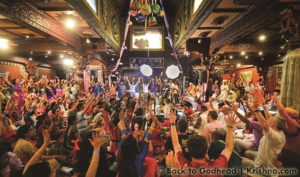
Devotees blissfully raise their arms and Chant Hare Krishna during one of New Vrindaban’s biannual 24 Hour Kirtan festivals.
Spring of 1969 saw Prabhupada’s first visit to the farm, and he loved it. He stayed a little over a month, but he made it clear that New Vrindaban was home. After he left, he continued to guide his disciples on transcendental life in a rural environment through many letters and even a few subsequent visits, in 1972, 1974, and 1976.
By August 1970 almost fifty residents were living at the community, and the number would keep growing. Beautiful hand-carved white marble deities were imported from India and installed on Janmashtami, August 13, 1971, and after that, New Vrindaban grew like wildfire.
Throughout the 1970s, cows, peacocks, and additional land were acquired, until New Vrindaban –initially some 138 acres – would eventually boast nearly 2,500, with devotees anxious to join from all quarters.
Hayagriva wrote in 1972: “In ’69 and ’70 we built cottages and gradually expanded to include a dozen people. Then in the winter of ’70, we began making Spiritual Sky incense and distributing it through the city temples. This proved to be a real gold mine. By the spring of ’71 sufficient money came in to enable us to buy the other two farms [nearby], and as soon as we did people started pouring in.”8 Kirtanananda Swami became a leading ISKCON sannyasi, and his project became one of ISKCON’s premier pilgrimage sites, with devotees worldwide attending its many annual festivals.
A tour de force development was Prabhupada’s Palace of Gold. (See my article in Back to Godhead, May/June 2016.) Conceived in 1972 as a comfortable residence for Prabhupada whenever he visited New Vrindaban, it was still unfinished when he departed this world in November 1977. The idea morphed into its being a memorial shrine, and with that vision the devotees continued to work on it as a lasting tribute to Srila Prabhupada. Upon its completion in 1979, it exceeded everyone’s wildest dreams – a dazzling, highly wrought, even otherworldly palace of marble, gold, carved teakwood, and the blood, sweat, and tears of numerous dedicated devotees – a fitting tribute to the modern world’s greatest spiritual master.
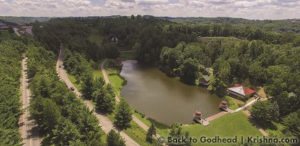
An aerial photo of the heart of New Vrindaban. Srila Prabhupada’s Palace is on the upper left. Thirty foot tall Gaura Nitai sculptures can be seen in the center, just above Kusum Sarovara Lake and below Govardhan Hill. To the right are cabins, Yogashala and Community Gardens.
“It’s hard to believe that Prabhupada’s Palace is in West Virginia,” wrote the Courier-Journal of Louisville, Kentucky. “In fact, it’s hard to believe it’s on this planet.”9 Life magazine told readers that the Palace is “a place where tourists can come and be amazed.”10 The New York Times summed it up: “Welcome to Heaven.”11 The Palace was unquestionably a highpoint in New Vrindaban’s achievements, and throughout the 1980s it reaped the benefits of the devotees’ monumental endeavor.
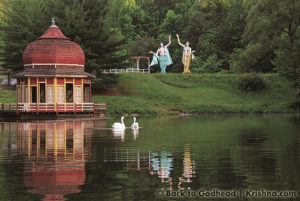
Swans gracefully glide across the lake in front of Sri Sri Radha Vrindaban Chandra’s boat house and Gaura Nitai.
Unfortunately, Kirtanananda Swami, though a qualified and noble leader in many ways, temporarily brought New Vrindaban to its knees, leading it into questionable and deplorable realms, some illegal, for which he was reprimanded and given a jail sentence, as were others. Naturally, the Governing Body Commission of ISKCON deposed him, for his wayward activity was not representative of the movement’s ideals and teachings. Thus he was excommunicated from the movement in 1994.
Throughout the 1990s and into the early years of the twenty-first century, New Vrindaban suffered, even as the Palace, at first, continued to thrive and receive many visitors. But signs of decay soon appeared. New Vrindaban’s troubles became the stuff of books and news articles, causing even sincere followers to leave. Various deviations continued to occur. As a result, from the early 1990s until only recently the Palace suffered financially, causing maintenance to be neglected and an overall downward spiral, but one that was not to last.
As the first decade of the twenty-first century came to a close, a new day dawned, and New Vrindaban started to rebuild. By 2011 a new team of dedicated devotees picked up where the old crew had left off, with some of the older devotees staying on and gaining new momentum. New acolytes joined hands with New Vrindaban stalwarts and worked diligently to revamp the original spiritual vision of Prabhupada’s first farm community. It is now on solid ground, with the community learning from previous mistakes. Indeed, fifty thousand tourists and pilgrims still visit each year.12In recent years an ambitious multi-million dollar renewal effort has been set in place, with an enthusiasm that rivals the Palace’s initial construction.13
Part II: The Five Principles of New Vrindaban
Here we briefly survey the five components that Prabhupada mandated for New Vrindaban: (1) cow protection, (2) simple living, (3) spiritual education, (4) holy pilgrimage, (5) and loving Krishna.
- Cow Protection

Sukhayanti Dasi, Nila Gopala Dasa, and their two young daughters, Sudevi and Rangadevi, greet Sriya at the community’s Nandagram Farm.
“Krishna by His practical example,” Prabhupada wrote, “taught us to give all protection to the cows, and that should be the main business of New Vrindaban.”14 Apropos of this, New Vrindaban is home to the first and longest-running cow-protection program in ISKCON and the Western world. It has been in operation since the spring of 1969, when the community’s first cow, Kaliya, made her way into the association of devotees. The heroes who have championed the cow program at New Vrindaban are many, but one devotee in particular has worked hard to make this a reality.
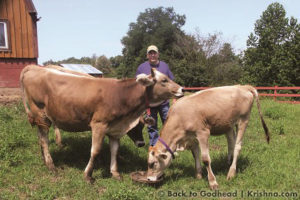
Ranaka Dasa, who has steadily cared for the cows in New Vrindaban for more than 40 years, stands with the three heifers shown in a previous photo.
Doug Fintel was born in 1954 in Norfolk, Virginia. Raised on a farm in northwest Iowa, he migrated to the mountains outside Denver, Colorado, where he deepened his love for nature. His involvement in the counterculture of the 1960s reached a highpoint when he met the devotees of Krishna, particularly Padmanabha and Mahotsava, a husband-and-wife team looking for interested seekers in that part of the country. Doug had started a firewood business, but the devotees won his heart, and he began to think how he could engage as one of them more directly.
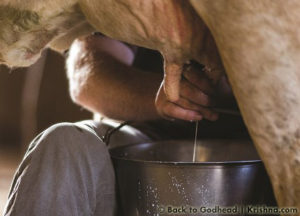
Twice daily, every day of the year, Ananda Vidya Dasa and Lalita Gopi Dasi lovingly milk the protected cows that provide dairy products for the deities and devotees.
Frequenting the Denver ISKCON temple in the winter of 1976, he liked the idea of a farm community dedicated to Krishna, and New Vrindaban seemed a natural fit. His general psychophysical makeup and his background in rural America made him just the right man for a back-to-the-land Krishna conscious environment, especially for the plow department and farm work. He has been in New Vrindaban, serving faithfully, since before Prabhupada’s departure from this world. In fact, he had heard about Prabhupada’s love for New Vrindaban’s cow-protection program soon after he joined ISKCON in 1977. New Vrindaban was abuzz with Prabhupada’s recent visit. Madhava Smullen writes,
In 1976, when [Prabhupada] visited New Vrindaban for the last time, the community was caring for four working teams of oxen and over 150 cows. A new barn had been erected in Bahulaban [one of New Vrindaban’s first sectors], and Prabhupada visited it to see the cows and four newborn calves. He let one of them lick his hand as a devotee told him how the cows were yielding about 120 gallons of milk every day, which they were turning into ghee, cheese and buttermilk. Prabhupada was pleased.15
Doug, initiated as Ranaka Dasa, gradually became more and more involved with New Vrindaban’s cows and is now, with their help of course, producing “ahimsa milk” – consciously trying to avoid any pain for the dairy cows on the farm.
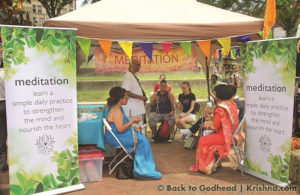
New Vrindaban devotees show festival participants how to chant japa during the second annual Wheeling Ratha Yatra.
Ranaka is looking for a sustainable model for the future.
“In the past,” he says, “New Vrindaban was known for its huge dairy production, but we couldn’t take care of the cows properly. So we’re looking for balance, a sustainable model for the future, where the cows are happy and produce in abundance. I think we’re getting there.”
- Simple Living
Prabhupada sometimes referred to self-sufficiency with the phrase “simple living,” reminiscent of his ISKCON Statement of Purpose #6: “To bring the members closer together for the purpose of teaching a simpler and more natural way of life.” Using the things of this world in God’s service is real renunciation, or saintly life. It is called yukta-vairagya. As Prabhupada wrote: “Yukta Vairagya means that we should simply accept the bare necessities of our material part of life, and try to save time for spiritual advancement. This should be the motto of New Vrindaban.”16
One New Vrindaban devotee who embodies that mood is Vidya Devi Dasi. Born in Wisconsin as Mary Smith in 1949, she and her husband, Madhava Ghosha, now deceased, came from rustic, agrarian backgrounds and had always put a premium on intelligent agriculture, even before they joined Prabhupada’s farm community. Her ancestors were among the first settlers in Wisconsin, developing sophisticated agronomical techniques early on.
“It’s in my DNA,” she says. “I was born on a farm, and I’ve been living close to the land from childhood.”
She arrived in New Vrindaban in 1972 and met Madhava a few years after settling there. They devoted their lives to gardening for Krishna, growing vegetables and flowers for the community while raising their five children. She’s especially fond of the gorgeous and variegated gardens at Prabhupada’s Palace, which she nurtured from the ground up, their beauty competing with the Palace itself.
But even prior to the Palace, she and the other New Vrindaban farmhands performed natural miracles. By 1974 the Bahulaban temple garden expanded to 1.5 acres, with similar large gardens in the sections of New Vrindaban known as Vrindaban and Madhuban. Plantings included more than thirty kinds of vegetables, fruits, and herbs, along with oats, which became a staple in New Vrindaban.
Teams of horses plowed the fields. Devotees involved included Varshana Swami (then Kashyapa Dasa), Tejomaya, Manonatha, Madhava Ghosha, Advaitacharya, and Tapah-punja, among others. A greenhouse, built in 1975, extended growing periods and allowed flower growing during winter.
Vidya also started a side business, called Nature Crafting. She would grow and sell tomatoes, herbs, flowers, and other crops, and she would teach the locals the value of organic gardening for both consumers and the environment. She laughs as she remembers how they would grow gourds of all shapes and sizes. These became among their most popular items. She would paint them and turn them into birdhouses and even Jagannatha deities, which sold well. Prabhupada’s strong endorsement for this kind of work came in 1976: “Yes. Anything grown in the garden, that is hundred times [more] valuable than [if] it is purchased from the market.”17
ECO-Vrindaban (ECO-V), a nonprofit organization, was started in 1998 to care for New Vrindaban’s cows, and in 2014 it also took responsibility for locally grown crops and flowers, continuing and expanding New Vrindaban’s self-sufficiency program. By caring for New Vrindaban’s bovine life, particularly by milking its happy and productive dairy cows, and by developing sustainable agriculture, ECO-V has been realizing Srila Prabhupada’s vision of simple living for the devotee community.
- Spiritual Education
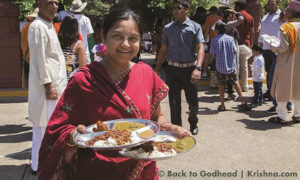
Pilgrims enjoy tasty prasadam outside Sri Sri Radha Vrindaban Chandra’s temple during Labor Day festivities September 2017.
Prabhupada often said that people are suffering due to a lack of knowledge. His hope was that through spiritual education, people would become happy. This aligns with his ISKCON Statement of Purpose #1: “To systematically propagate spiritual knowledge to society at large and to educate all people in the techniques of spiritual life in order to check the imbalance of values in life and to achieve real unity and peace in the world.”
Prabhupada wrote, “It is necessary for the leaders of the Krishna consciousness movement to start educational institutions in different parts of the world to train children, starting at the age of five years. Thus such children will not become hippies or spoiled children of society; rather, they can all become devotees of the Lord. The face of the world will then change automatically.”18
Specifically for New Vrindaban, he wrote, “Please now try to organize a children’s school. This is one of our programs in New Vrindaban. . . . You can form a school committee and get it recognized by the Education Board. Then more children will be sent.”19 The realization of Srila Prabhupada’s educational dream for New Vrindaban has been spotty, with various successes and failures. But the community continues to keep the goal in mind, and various attempts are being made to implement both children’s schooling and higher education.
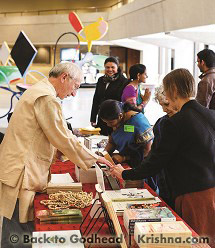
Sankirtan Dasa & Ruci Dasi greet guests after a Mahabarat dramatic storytelling at the University of Cincinnati.
Sankirtana Dasa and Ruci Devi Dasi, Andy and Ruth Fraenkel, are two names that stand out in the realm of New Vrindaban education. The couple met in college in 1968, were initiated in 1973, and arrived in New Vrindaban by 1976. And for the next forty years, Ruci, especially, dedicated herself to teaching preschool and elementary school to prepare children for a life of devotional service to Krishna, but no less for the rigors of living in the outside world. While Sankirtana has underlined the importance of education through storytelling and dramatic performance, for which he has won significant accolades and awards, Ruci has concentrated her focus on schools and an academic environment.
Way back in the 1970s when the New Vrindaban school was called Nandagram, the small classrooms for boys and girls gradually grew into one of the largest ISKCON gurukulas in the world. But the ashram-based facility was shut down by the end of the 1980s. Then, from 1989 to the late 1990s, there was a day school, which grew into Gopal’s Garden, opened by Ruci in 2007. Gradually, the New Vrindaban educational system evolved into a homeschooling cooperative that keeps improving.
“Today,” writes Madhava Smullen, “[Ruci] continues to teach at the Gopal’s Garden Homeschool Co-op, established in 2007.” There she provides a balanced blend of standard academic subjects and Krishna conscious education. At the end of each school year, she produces an anthology of the students’ writings and illustrations, now used in ISKCON schools worldwide.
- Holy Pilgrimage
Among the several farm projects and rural communities started by Srila Prabhupada, only New Vrindaban was given the mandate to build replicas of holy places of Vrindavan: “There will be seven principal temples, namely, Govinda, Gopinatha, Madana Mohana, Syamasundara, Radha Ramana, Radha Damodara, and Gokulananda.”20
Thus, from its inception New Vrindaban was seen not only as a pilgrimage site in its own right, but also as a reproduction of the original pilgrimage site – Vrindavan itself, home to the original temples of the Goswamis, leading followers of Lord Chaitanya.
“Activities exhibited by Krishna Himself at Bhauma Vrindavana, the Vrindavana-dhama existing on this planet,” wrote Srila Prabhupada, “are not different from His activities on the planet Goloka Vrindavana. This is proper realization of Vrindavana anywhere. In our Krishna consciousness movement we inaugurated the New Vrindavana activities, wherein devotees are always engaged in the transcendental loving service of the Lord, and this is not different from Goloka Vrindavana.”21
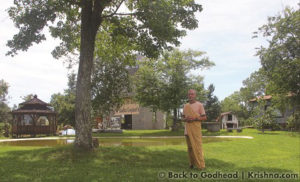
Varsana Swami stands near Radha Kunda, with the partially completed Radha Gopinath Mandir in the background.
One person who has taken the pilgrimage aspect of New Vrindaban to heart is Varshana Swami. Born John Mowen in 1950, he hails from Morristown, New Jersey, but spent many of his early years on his grandfather’s farm in Pulaski, in upstate New York. He also studied theology at St. Andrew’s College, but quickly decided that he could best pursue God in the forest, where he could pray and contemplate divinity without disturbance.
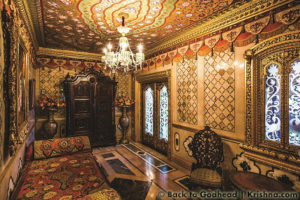
Prabhupada’s bedroom has walls inlaid with Italian Botticino marble and a ceiling with nearly one thousand hand-painted flowers.
It was in the forest that he met the devotees. He returned with them to the Brooklyn temple and took up devotional practices. This was in 1972. Relocating to New Vrindaban, he was initiated by Prabhupada a year later. He has been there ever since.
Varshana Swami gradually became known for landscaping, carving the holy area out of the existing contours of the West Virginia foothills. He has “excavated” replicas of Radha-kunda and Syama-kunda at Govardhana Hill in New Vrindaban, and is gradually constructing Radha-Gopinatha Mandir, the first of Srila Prabhupada’s proposed replicas of the seven main temples of Vrindavan. This has become a prized pilgrimage spot for visitors. As time goes on, the other temples will manifest as well, and pilgrims will come from all over the world, as they do now to see the Palace of Gold. Varshana Swami clearly has a calling to liberate these holy places from the raw landscape that is New Vrindaban.
- Loving Krishna
Ultimately all four of the above components work in concert to bring about love for Krishna, the fifth, if also the primary, principle of the New Vrindaban way of life. The third of the seven purposes of ISKCON is “To bring the members of the Society together with each other and nearer to Krishna, the prime entity, thus developing the idea within the members, and humanity at large, that each soul is part and parcel of the quality of Godhead (Krishna).” This is where New Vrindaban ultimately hopes to take the people who live there, and to carry all its visitors on that journey as well.
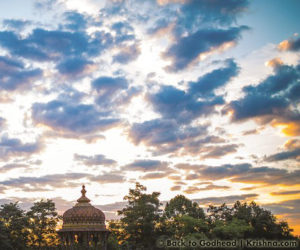
Sunrise seen through one of the four corner chattras that adorn the exterior terrace of Prabhupada’s Palace
Notes
- The earthly replica of Vrindavana in the spiritual world is spelled “Vrindavan” on modern maps. Srila Prabhupada used the Bengali-style spelling when naming “New Vrindaban.”
- Richard Rose, The San Francisco Oracle, December 1967.
- Hayagriva Dasa, “Chant,” Brijabasi Spirit, November 1981, p. 20.
- Letter from Prabhupada, 8/23/68. Quoted in Hayagriva Dasa, “New Vrindaban,” in Back to Godhead, Feb. 1, 1969 (Vol. 1, No. 23). Online version: http://www.backtogodhead.in/new-vrindaban-hayagriva-dasa/
- Brahmananda’s letter, dated September 7, 1968, and approved by Prabhupada, summed up their master’s vision for New Vrindaban in those earliest days: “It has a farmhouse and several other structures, a well, streams, hills (Govardhan, as named by Swamiji [Prabhupada]), pasture grounds (a cow will be acquired soon), ghat, pond, woodland, all situated on 138 acres. Prabhupada has requested that 7 temples be established there. Its main activity will be cow protection and to show the world that simply by living with cows and land and chanting HARE KRISHNA a perfect society will prevail. . . . A great deal of work is required and Swamiji has requested at least four devotees to go there immediately. New Vrindaban lacks [such] so-called necessities as hot running water and toilets, so that only stout and sturdy devotees are needed, especially those with carpentry experience and can do manual labor.”
- Srila Prabhupada letter to Hayagriva, 3/17/68.
- Srila Prabhupada letter to Kirtanananda Swami, 9/22/68.
- Howard Wheeler, “New Vrindaban: A Hare Krishna Community in West Virginia,” Mother Earth News,July/August 1972.
- “Children of Krishna: Seeking heaven in West Virginia,” Courier-Journal Magazine (Sunday, February 10, 1980).
- Hillary Johnson, “Children of a Harsh Bliss: In a West Virginia Commune, an Extraordinary Look at Life and Love Among the Krishnas,” Life(April 1980).
- Edward Schumacher, “West Virginia Marvels at Indian Palace,” The New York Times(Monday, September 3, 1979).
- Sarah Pulliam, “A lower-key kind of Krishna,” Columbus Dispatch(July 18, 2008).
- http://www.palaceofgold.com/history.html
- Srila Prabhupada letter to Hayagriva, 6/14/68.
- http://www.brijabasispirit.com/2016/01/07/srila-prabhupada-kaliya-iskcon…
- https://vanisource.org/wiki/680614_-_Letter_to_Hayagriva_written_from_Montreal
- https://vanisource.org/wiki/760803_-_Conversation_C_-_New_Mayapur
- Srimad-Bhagavatam4.12.23, Purport.
- https://vanisource.org/wiki/691207_-_Letter_to_Ranadhir_written_from_London
- https://vanisource.org/wiki/680823_-_Letter_to_Kirtanananda_and_Hayagriva_written_from_Montreal
- http://vanisource.org/wiki/CC_Madhya_7.69
- http://www.brijabasispirit.com/2016/10/16/new-vrindaban-devotees-serve-P…
About the Author:
Satyaraja Dasa (Steven Rosen) is an initiated disciple of His Divine Grace A. C. Bhaktivedanta Swami Prabhupada. He is also founding editor of the Journal of Vaishnava Studies and associate editor of Back to Godhead magazine.
Extra
Going Forward
On the central altar of the New Vrindaban temple stand Sri Sri Radha–Vrindaban-Chandra – Radha with Krishna as “the moon of Vrindavana.” They are accompanied by deities of Gopala Nathji, Gaura-Nitai, Jagannatha, Baladeva, and Subhadra, and Narasimha and Prahlada. Opened in 1983, the temple is elegant beyond words and competes with the Palace for the devotees’ attention.
But the land and the cows will always hold a special place in the hearts of New Vrindaban residents. Although the landscaping and the development of various farm projects have been ongoing since the community’s inception, there is more to do.
Recently a Yogashala opened just down the road from the main temple, and it hosts courses on yoga, meditation, and kirtana. This is part of a new outreach program meant to augment the Palace as a draw for outsiders. But the Palace is still the main attraction. New Vrindaban remains a holy place for pilgrims and a destination for many Western tourists, mainly because of the Palace of Gold.
Madhava Smullen wrote in October 2016:
It’s a reasonable expectation: this year, overall tourism at Prabhupada’s Palace already increased from 20,000 annually to approximately 30,000. Vrajadhama [now Vrajakishora Dasa, the new manager for Prabhupada’s Palace] attributes this to stronger social media presence, as well as an increasing interest from TV, radio and print media.
“It’s really about getting ourselves out there,” says Vrajadhama. “Because we have so much to offer. People are becoming aware that we’re doing a lot of work here, and that we’re ready to reintroduce ourselves to the world. They’re excited about that, and they want to come and see what we’re up to.”22
Apropos of New Vrindaban’s readiness for the future, the year 2018, its fiftieth anniversary, promises to be a major step forward. Several steps, in fact. To begin, five main events will commemorate the fiftieth in glorious New Vrindaban style. People will come from around the world for two weekend extravaganzas, particularly for congregation/donors, that start off the festival year in March and April. VIP events for West Virginia government officials and ISKCON dignitaries begin in May.
During the summer there will be an open-house weekend for the public, with advertising that is sure to bring busloads of tourists from around the country and devotees from around the world. Finally, the main event will be a huge semicentennial celebration in September, commemorating the founding of New Vrindaban. In addition, all of New Vrindaban’s usual annual events will continue in a bigger and better way, including Gaura Purnima, Nrisimha Caturdashi, Festival of Inspiration, 24 Hour Kirtan, Janmashtami, Radhashtami, Wheeling Rathayatra, Prabhupada’s Appearance Day, and the Festival of Colors.
Timeline
1968
January 22
First known mention of “New Vrindaban” in a letter from Srila Prabhupada.
August 8
Founding of New Vrindaban with Hayagriva’s signing of a 99-year lease.
August 23
Prabhupada’s letter to Kirtanananda and Hayagriva fully authorizing the establishment of New Vrindaban.
1969
Spring
Purchase of Kaliya (the community’s first cow) and the start of ISKCON’s cow-protection program.
May 21–June 22
Srila Prabhupada’s first visit.
1970
August
First New Vrindaban Janmashtami festival.
1971
Winter
Large Jagannatha, Baladeva, and Subhadra carved in Pittsburgh by Nara Narayana Dasa.
August
Janmashtami: Radha–Vrindaban-Chandra installation ceremony at the Vrindaban farmhouse.
1972
May
Bahulaban temple opens, and Radha–Vrindaban-Chandra move there from the Vrindaban farmhouse.
August 31–September 8
Srila Prabhupada’s second visit.
New Vrindaban sees the arrival of its twenty-first cow.
1973
Spring
Guruban property purchased (future site of Prabhupada’s Palace).
June 2–3
Groundbreaking ceremony for Prabhupada’s Palace and Govindaji Temple.
Installation of Radha-Madhava at Madhuban and Radha–Vrindaban-Natha at Vrindaban.
August 23
New Vrindaban Community, Inc. incorporated by Hayagriva, Paramananda Dasa, and others.
1974
April
First issue of Brijabasi Spiritnewsletter published.
July 18–23
Srila Prabhupada’s third visit, and the first to his future palace.
1975
August
113 total cows in the herd: 47 milk cows, 27 heifers, 35 oxen, and 4 bulls.
September
New Vrindaban: The Spiritual Frontier, ISKCON Cinema movie released.
Fall
Big Gaura-Nitai deities move from Buffalo to New Vrindaban.
1976
June 21–July 2
Srila Prabhupada’s fourth (and final) visit.
1977
January
Kaliya, the first New Vrindaban and ISKCON cow, passes away at Vrindaban Farm.
1978
150 total cows in the herd.
1979
September 2
Dedication ceremony of Srila Prabhupada’s Palace of Gold.
1981
Labor Day
Dharmasala guest lodge opens.
Spring
Varnashram College, a vocational school for teenage boys, starts (35 students by spring 1983).
1982
March/April
Palace Gift Store and Restaurant opens.
Guest cabins open.
The State of West Virginia recognizes New Vrindaban as an unincorporated town.
1983
January
Cow population approximately 300.
March
WV Dept. of Highways adds New Vrindaban to official state map.
July 4
Radha–Vrindaban-Chandra’s Temple of Understanding opens. Deities move from Bahulaban. Sri Gopala Nathji installation.
1984
January
Two temple lakes completed, Kaliya Ghat (now called Kusum Sarovara) and Chaitanya Ghat.
1985
Winter
Large Gaura-Nitai sculptures dedicated.
Spring
Govardhan Dairy is opened in Valley Barn, built to handle 200 milking cows.
1986
January 6
Nrisimhadeva and Prahlada deities installed.
March
Malini the elephant arrives.
1987
March
Kirtanananda expelled from ISKCON.
June
Prabhupada’s Palace rose garden wins prestigious award from All-American Rose Selections.
1988
February
New Vrindaban expelled from ISKCON.
Difficult period, experimentation with Vaishnava/Christian blend.
1991
June 26
Census: 300 residents (131 adults).
1994
March
New Vrindaban officially excludes Kirtanananda Swami.
May
Brijabasi Spirit returns focus to Srila Prabhupada and his vision for New Vrindaban.
1995
Winter
Danavira Goswami and his Rupanuga Vedic College move to New Vrindaban, as does ISCOWP (International Society for Cow Protection).
1998
February
New Vrindaban provisionally accepted back into ISKCON. ECO-Vrindaban (GEETA) started.
2000
May
Inaugural Festival of Inspiration.
Fall
New Vrindaban fully accepted back into ISKCON.
2006
March
Prabhupada’s Palace formally recognized by GBC as Smriti Samadhi.
2007
June
Inaugural 24 Hour Kirtan Festival.
September
Gopal’s Garden Home School Co-op opens.
2008
September 11
New Vrindaban Community, Inc. name changed to ISKCON New Vrindaban, Inc.
2010
April
Palace Renovation Committee started.
2012
April
Start of construction for Radha- Gopinatha Temple by Dham Seva, Inc.
July 10
CNN calls Prabhupada’s Palace one of the “8 religious wonders to see in the U.S.”
September
Inaugural Festival of Colors.
2014
Summer
Renovations on Palace entrance and front steps begin.
2016
December
Prabhupada’s Palace front steps renovation completed.
July 16
First Rathayatra in Wheeling, WV.
2017
April 15
Yoga Shala inaugurated.
Autumn
Prabhupada’s Palace outer wall renovation completed.
2018
New Vrindaban’s Fiftieth Anniversary.
2019
Celebrations to come:
April
ISKCON Cow Protection Fiftieth Anniversary.
September
Prabhupada’s Palace Fortieth Anniversary.
